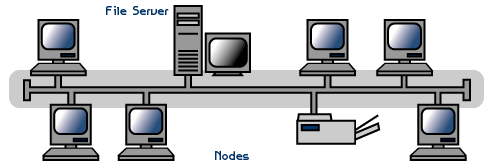Definition
- Network Topology refers to the layout of a network and how different nodes in a network are connected to each other and how they communicate. Topologies are either physical (the physical layout of devices on a network) or logical (the way that the signals act on the network media, or the way that the data passes through the network from one device to the next).
Types of Network Topology
1. Star Topology
Main Advantage : In a star network, one malfunctioning node doesn't affect the rest of the network.
Main Disadvantage: If the central computer fails, the entire network becomes unusable.
2. Bus Topology

Ring Topology: A local-area network (LAN) whose topology is a ring. That is, all of the nodes are connected in a closed loop. Messages travel around the ring, with each node reading those messages addressed to it.
Main Advantage: One main advantage to a ring network is that it can span larger distances than other types of networks, such as bus networks, because each node regenerates messages as they pass through it.
Main Disadvantages : Each packet of data must pass through all the computers between source and destination. This makes it slower than Star topology.
